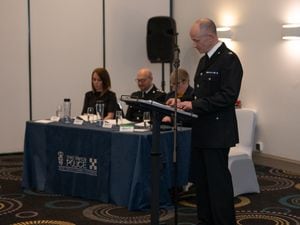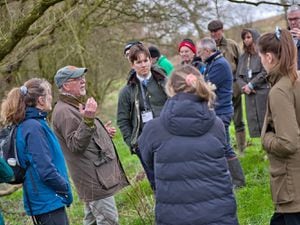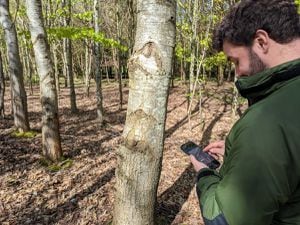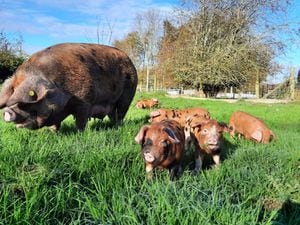Census reveals changing face of Shropshire
It's little wonder that doctors, hospitals and social services are being stretched to bursting point across Shropshire.
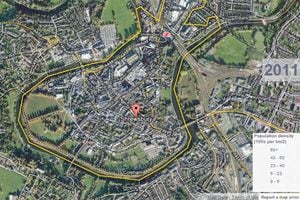
For not only is the county's population growing faster than the national average in many areas, but the average age of the people who live here is rapidly rising too.
Broken down into different areas of Shropshire, latest analysis of the 2011 Census, issued by the Office for National Statistics, show dramatic indications of the shifting sands of the county's population and implicitly highlighting one of the major challenges for now and for the future – providing services and care for older Salopians.
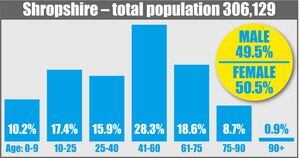
Few areas now have average aged populations below 40, and many are either above 50 (like Ludlow and Church Stretton), or close to it (like Bridgnorth, Shifnal, Craven Arms and Bishop's Castle).
However the picture is highly complex, with some areas actually showing a drop in the elderly population, suggesting that more than ever people are making choices about where they live.
Particularly striking are the figures for Ludlow, traditionally seen as a prime retirement haunt.
In our featured area within the SY8 postcode, taking in the central area including the Bull Ring, part of Broad Street, and Old Street, there has been a mass exodus, with over 1,000 fewer residents now compared to 10 years ago.
The percentage of people of retirement age in this part of the town centre has also come down, and the median age of the population has dropped from 53 to 51.
Our spotlight in the TF1 area of Telford falls on part of Wellington which includes Victoria Road, Bridge Street, Market Street, and Glebe Street, where again the comfortable assumptions about a general rise in the elderly population are blown away by the statistics. Over the past 10 years the median age here has fallen by five years, from 41 to 36, against a background in which this part of Wellington has seen a significant overall rise in the population.
Compared to other places in Shropshire, the proportion of retirement age folk here has dropped drastically, from 21.5 per cent in the 2001 census figures, to 13.1 in 2011.
Our sample figures for the SY1 district take in the centre of Shrewsbury within the loop of the river where the overall population is almost 1,000 more than it was at the time of the 2001 census. The town centre is more densely populated, perhaps pointing to a resurgence and revitalisation of the town centre as a place to live, as evidenced by various new developments.
The population, measured in hundreds per square kilometre, has gone up from 16.1 in 2001 to 26.7 in 2011.
Our TF9 patch shines the spotlight on Market Drayton town centre, taking in the patch to the north of the centre and including Maer Lane, Cheshire Street, Smithfield Road, and part of Stafford Road. Again, it's a picture of a rising population, although more modest than in Shrewsbury. This rise has been driven by an increasing percentage from the 16 to 64 age group. The percentage of those under 15 and 65 and over has actually fallen with the result that the median age, at 36, shows no difference to that of 10 years ago.
The percentage of retirement age people now living in the SY11 postcode in Oswestry has fallen by over four per cent. Here our featured patch takes in the part of the town centre including English Walls, Castle View, Church Street, and Oswald Road.
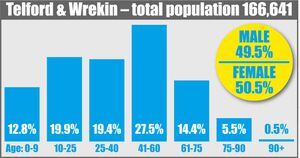
Whitchurch centre falls in line with the pattern with the percentage of 65 and overs in a swathe of the town centre, including Bargates, High Street, London Road, and Brownlow Street, falling from 18.8 to 16.6, again against the background of a rising town centre population. Here the percentage of 15-and-unders has fallen from 19.2 in 2001 to 17.9.
So what about Bridgnorth? The proportion of youngsters has fallen, but not much, and it is also proving a place that the older generation like to live in. In 2001 the census showed 14.3 per cent of the population in a patch including parts of Low Town such as Bridge Street and Severn Street, and also a slice of High Town to include Listley Street and High Street, were of retirement age. The percentage in the 2011 census was 19.1.
Having looked at the picture in Shropshire's towns, where the census results showing highly localised variations, a peek in the rural part of the county gives a different perspective, but falls broadly within the general picture.
The area east of Church Stretton, taking in places like Chelmick and Longville, is quintessential rural Shropshire. Here the population has risen only slightly, from 1,118 to 1,207, and the proportion of those aged 15 and under has fallen from 21.2 to 18.2. In the middle band, the 16 to 64 age group is fairly static, at 60.7 per cent, compared with 61.4 in 2001, while the retirement age constituency has made an advance from 17.4 per cent to 21 per cent, helping take the median age from 43 to 47.
Almost everywhere, the average age of residents has risen. Shrewsbury is up from 37 to 40; Telford from 33 to 37; Oswestry from 37 to 38; Cleobury Mortimer from 40 to 43; Wem from 39 to 43; Whitchurch from 39 to 42; Market Drayton from 40 to 44; and Craven Arms from 45 to 48.
Across the border in Powys, the average ages of the Welshpool and Newtown populations now both stand at 40.
All of this comes against a backdrop of an increase of more than 31,000 in the overall Shropshire population between 2001 and 2011.
The number of people living in the county's two unitary authority areas stood at 472,770 after the 2011 Census, a rise of more than seven per cent on 2001, when the figure was 441,744.
The Shropshire Council area is growing much more rapidly than the borough of Telford & Wrekin, and has a far higher proportion of pensioners, and its towns and villages are more more reliant on tourism.
The Shropshire Council area saw an 8.1 per cent population rise over the survey period, from 283,190 to 306,129, while Telford & Wrekin's total was up 5.1 per cent from 158,554 to 166,641. The county of Powys, saw its population rise 5.2 per cent during the 10-year period, from 126,403, to 132,976.
Women outnumber men by more than 4,400. There are 154,523 women in Shropshire, compared with 151,606 men, and 84,092 women in Telford & Wrekin, against 82,549 men.
Telford & Wrekin has the highest number of youngsters, with 12.8 per cent of the population aged under nine compared with 10.2 per cent in Shropshire. The number of under-25s in Telford & Wrekin is also higher than in the rest of Shropshire – 32.7 per cent against 27.6 per cent.
There is little to choose in the proportion of middle-aged residents, with 27.5 per cent aged between 40 and 65 in Telford & Wrekin, and a marginally higher 28.3 per cent in Shropshire.
But when it comes to residents either above or nearing retirement age, the Shropshire figure is much higher. There are 18.4 per cent aged between 60 and 75, a further 8.5 per cent aged between 75 and 90, and 0.9 per cent aged over 90. In contrast, Telford & Wrekin has 14.3 per cent of residents aged 60-75, 5.5 per cent between 75 and 90, and just 0.5 per cent aged over 90.
The percentage of the population aged 65 and over across England and Wales was the highest seen in any census at 16.4 per cent – one in six people in the population. The figure in the Shropshire Council area was even higher, at more than one in five people (20.4 per cent), while Telford & Wrekin's total was below the national average on 14.4 per cent.
The latest batch of figures also illustrate the region's increasing reliance on the tourism and leisure sector.
In Shropshire, a total of 8.3 per cent of all jobs are now related to the tourism industry, compared with 6.9 per cent in Telford & Wrekin.
Shropshire Council leader, Keith Barrow, said: "Tourism is an increasingly important aspect of the county's economy and that comes as no surprise. With somewhere as beautiful as Shropshire, we have to expect that tourism will play a big part in the livelihood of people who live in our towns and villages."
As far as Telford & Wrekin's Census numbers are concerned, there is a degree of scepticism. Councillor Kuldip Sahota, leader of Telford & Wrekin Council, said: "We've had a long-running argument with the Government, saying our population is actually higher by about 4,000 people.
"We receive our grants in accordance with the number of people in our region, and we strongly believe that the population is under-counted. That means we do not receive as much in grants as we should."

